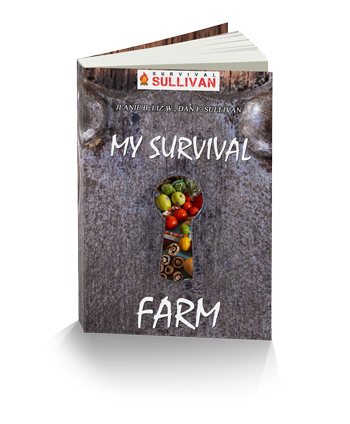*This post may contain affiliate links for which I earn commissions.*

I’ve always been a bit of a worrier. What if the grocery store shelves go empty? What if a natural disaster cuts off supply chains? What if the economy collapses and I can’t afford to feed my family? These thoughts used to keep me up at night—until I discovered the concept of a hidden garden for post-collapse food. It’s not just a garden; it’s a lifeline. When I found My Survival Farm, it felt like someone had handed me the exact blueprint I needed to turn my backyard into a self-sustaining food haven.
If you’ve ever wondered how you’d feed your family in a crisis, you’re not alone. The idea of growing your own food sounds great, but traditional gardening? It’s a lot of work. Digging, watering, fertilizing, weeding—honestly, who has the time? And what about when things get really tough, like during a prolonged emergency? That’s where My Survival Farm comes in. It’s a course that teaches you how to create a permaculture-based survival garden that’s low-maintenance, discreet, and incredibly productive. Here’s why it’s worth considering and what you might want to know before diving in.
Why a Hidden Garden for Post-Collapse Food Is a Game-Changer
Imagine this: a garden that doesn’t need daily watering, doesn’t require you to replant every year, and produces fresh, organic food no matter what’s happening in the world. That’s what My Survival Farm offers. It’s not just about growing veggies—it’s about creating an ecosystem that works for you, not against you.
I was drawn to this course because it’s designed for people like me: busy, not exactly a gardening expert, and a little paranoid about the future. The idea of a garden that could blend into my backyard, hidden from nosy neighbors or potential looters, was a huge selling point. In a post-collapse scenario, the last thing you want is a neon sign saying, “Hey, I’ve got food!” This garden is subtle, blending in like it’s just part of the landscape.
But it’s not just about hiding. It’s also about efficiency. The course teaches you how to grow up to 8 times more produce than a traditional garden in the same amount of space. I don’t have acres of land—just a small backyard—but this system makes it possible to grow enough to feed my family. Plus, it’s organic and packed with nutrients, which is a big deal when you’re thinking about long-term health during tough times.
And here’s the kicker: it works anywhere. I’ve read stories of people using these principles in the Jordanian Desert, South Africa, and even Alaska. It doesn’t matter if you’re dealing with scorching heat or freezing cold—this system adapts. That’s because it’s based on permaculture, a way of growing food that mimics nature. Plants, animals, insects, and even microorganisms all work together in harmony. It’s like having a mini ecosystem that takes care of itself.
Why Customers Want My Survival Farm
When I first came across My Survival Farm, I was skeptical. Could a garden really be this easy and effective? But the more I learned, the more I realized this wasn’t just another gardening course. Here’s why it’s different and why it’s exactly what people like us need:
- Self-Sufficiency in Any Crisis: Whether it’s a natural disaster, economic collapse, or something worse, this garden ensures you’ve got food. No relying on grocery stores or government aid.
- Low Effort, High Reward: I don’t have time to be a full-time gardener. This system requires no digging, no replanting, and minimal watering. Once it’s set up, it practically runs itself.
- Discreet and Secure: The garden is designed to be hidden in plain sight. No one will know you’ve got a food source unless you tell them.
- Perfect for Any Space: You don’t need a huge yard. Even urban dwellers can make this work with the course’s tips for small spaces.
- Nutritious and Organic: It’s not just about calories—it’s about health. The garden includes medicinal plants, which are a lifesaver when doctors and pharmacies aren’t an option.
- Family-Friendly Learning: I love that my kids can get involved. It’s simple enough for them to understand, and it teaches them how nature works.
- Extra Resources: The bonuses—like the Permaculture Action Plan and SHTF Water—cover everything from water storage to food preservation. It’s a complete survival package.
- Affordable and Risk-Free: At such a low price and with a 60-day money-back guarantee, it’s hard to say no.

Questions You Might Have (And How My Survival Farm Answers Them)
I had a ton of questions before I started. Here’s what I’ve learned, both from the course and my own experience:
How Much Space Do I Need?
You don’t need a sprawling farm. The course shows you how to make it work in small backyards, urban spaces, or even indoors. I started with just a corner of my yard, and it’s already producing more than I expected.
Will This Work in My Climate?
Yes. The system is designed for extreme conditions—think deserts, freezing winters, or humid tropics. The course even helps you choose plants that thrive in your specific area. I live in a place with unpredictable weather, and it’s been fine so far.
How Long Until I See Results?
It depends on what you plant, but some crops start producing in just a few months. The course walks you through setting up nutrient-rich soil and planting perennials, so you’re set for the long haul. I started seeing small harvests within the first season.
Do I Need Gardening Experience?
Not at all. I barely knew the difference between a spade and a shovel when I started. The course is step-by-step, with photos and diagrams. Even my 10-year-old could follow it.
How Does It Stay Hidden?
The garden uses natural design principles to blend in. Think layered plants, like tall trees shading shorter crops, so it just looks like a wild patch of greenery. No neat rows or obvious vegetable beds. It’s genius.
How Does It Work Without Watering or Fertilizing?
Permaculture is all about working with nature. The course teaches you how to set up the soil so it retains moisture and nutrients. Certain plants act as natural fertilizers, and the system is so balanced that it doesn’t need much intervention. I’ve barely watered mine, even during dry spells.
What About Pests?
No pesticides are needed. The course shows you which plants naturally repel pests. It’s like having built-in security guards for your garden. I’ve had way fewer bug problems than with my old vegetable patch.
What’s the “Weird” Mulch Thing?
It’s just a clever trick using something you already have at home (no spoilers—you’ll have to read the course). It’s safe, free, and super effective. I was amazed at how well it worked.
Is the Course Just for Gardens?
Nope. The bonuses cover everything from water storage to canning your extra produce. There’s even a guide on growing medicinal plants, which I’ve found invaluable. One of them helped me treat a nasty burn last summer.
What If I’m Stuck in the City?
The course has a whole section on urban permaculture. You can grow food on balconies, rooftops, or even inside. I’ve got a small indoor setup for herbs, and it’s been a game-changer.
How Much Food Can I Expect?
Enough to feed your family, even in a crisis. The course teaches you how to maximize yield with companion planting—basically, pairing plants that help each other grow. I’ve been shocked at how much I can harvest from such a small space.
Any Hidden Costs?
Not really. You might need a few basic tools, but nothing fancy. Most of what you need is already in your home or yard.
Final Thoughts: Your Hidden Garden Awaits
Starting a hidden garden for post-collapse food isn’t just about survival—it’s about peace of mind. Knowing I can feed my family no matter what happens is a weight off my shoulders. My Survival Farm made it so easy to get started, even for someone like me who’s not exactly a green thumb.
If you’re curious, don’t let fear hold you back. The course answers every question you could have, and then some. It’s like having a gardening expert and a survival coach rolled into one. Plus, the bonuses are worth the price alone.
Let’s grow together, one backyard at a time.


